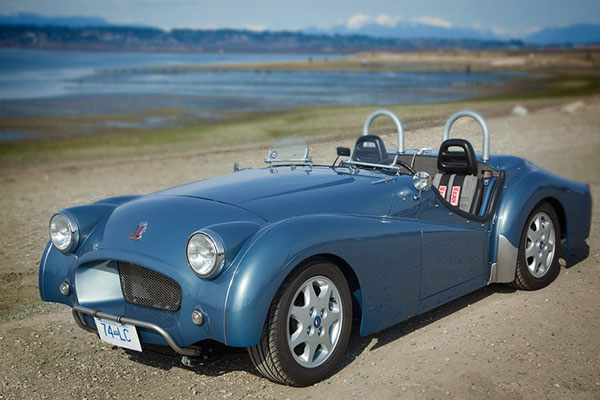
Randy Schultz's Triumph TR3 Plus 4 Project, Part 2
as published in BritishV8 Magazine, Volume XVII Issue 1, July 2009
by: Randall Schultz
It's finally finished! After logging over 2800 hours, it's hard to believe
there is now actually an automobile where there was none before. After the countless
hours of designing, fabricating, and assembling, all that's left is to actually
drive and enjoy the finished product.
In an earlier BritishV8 Magazine article, I documented the majority of the build of my
TR3 Plus 4. (The "Plus 4" part came about because I cut a Triumph TR3 body down the
center and widened it four inches so it would fit on a later TR6 frame and accomodate
both the TR6's rack-and-pinion steering and its independent rear suspension.) This
article is about the final details. It picks up where the first article concludes.
I've tried to focus on things that might be useful to others who are starting their
own major projects.
So, where does "part two" of the story logically start?
The Nissan engine fired up instantly. However, the first installation problem showed
up almost as instantly. The return line from the fuel injection system to the tank
was located too close to the suction line of the charcoal canister, which instantly
became fuel logged. After replacing the canister and re-routing the canister connection
point to the fuel tank, that problem was solved.
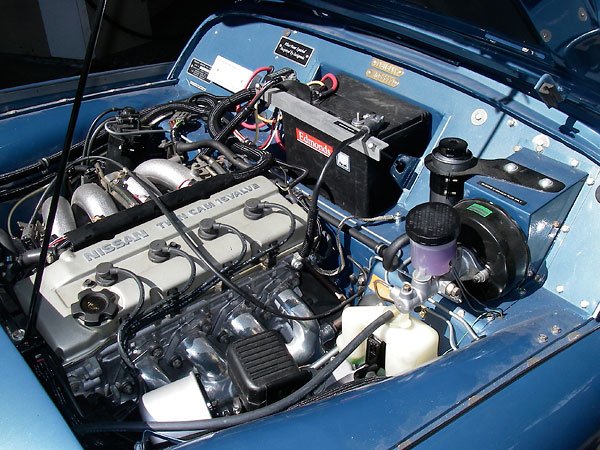
Getting an aftermarket (Classic Instruments) speedometer to work with the Nissan
PCM was a challenge too. The speedometer is designed to work with a simple digital
pulse generator, located on the transmission. I initially assumed that the Nissan
PCM could use the same signal, but in fact it requires a differently "conditioned"
signal from what the gauge expects to see. A friend who teaches this stuff at a
local technical college saved the day. We mocked the whole thing up using a drill
press turning at a known RPM driving the pulse generator, connected to the gauge,
also connected to a digital readout of the pulse waves. This is how we discovered
the original pulse to the Nissan's PCM was not the same as the pulse delivered
to the gauge. Our solution was to strip out the original PC board from the Nissan
gauge cluster and connect it in parallel with the aftermarket speedometer. People
who see the completed project rarely realize the research and development involved!
Come to think of it, there were a couple other challenging engine installation
details to work out. When I reversed the oil pan (see
previous article)
I realized that the position of the dipstick would no longer work, because it
now pointed to the low end of the pan. Because the dipstick runs through the
engine block, I knew I had an issue. Drilling the block for a new location for
the dipstick was not going to be an option, so I decided to connect an external
tube to the side of the reversed pan near the bottom of the pan. Oil in the pan
would obviously be the same level in the tub, and this became the new home for
a slightly modified-length dipstick. Putting in the exact capacity oil in the
crankcase, seeing where it came to on the dipstick and making a line on the stick
indicating "full" was all I needed.
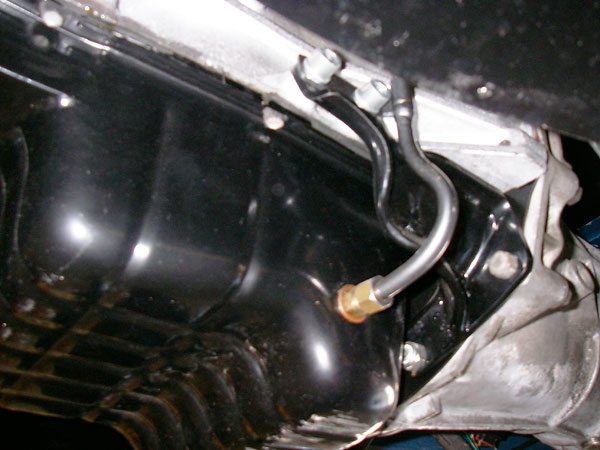
On the engine's induction side, I designed an aluminum air-box to house the engine air filter and serve as a connection point for the MAF ("mass airflow") sensor. Since space was really tight for this, the only point where the MAF could join the air box was at a corner. To make it even more challenging, the MAF sensor wanted a round mount section, and the corner of the planned box was square. I needed to map out the point of intersection where the round tube met the square corner.
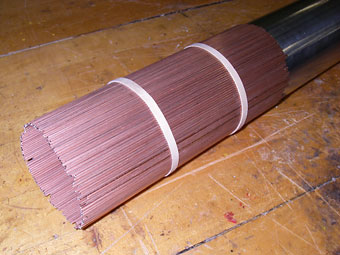
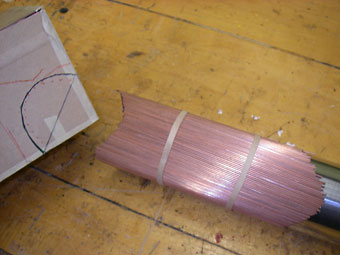
My solution was to construct a simple shop-built layout tool specifically for the
job. I took a length of the same tubing I planned to use for the actual part,
surrounded it with as many sixteenth inch welding rod pieces as it took to go
around its circumferance, and secured the rods in place with a couple of rubberbands.
The rods extended past the end of the tube by a few inches. Holding the tube at
the angle and location that I wanted to make the connection, I simply pushed the
whole affair into the corner of my cardboard mock-up. The rods slid to conform
with the mating surface, and it was easy to trace out the contour of the
intersection on the three surfaces that comprised the corner of the box.
Very accurate cut-lines efficiently facilitated a tight connection. With no
gaps greater than one sixteenth of an inch, it was easy to TIG weld the parts
together.
On the engine's other side, I had to create a unique exhaust downpipe arrangement.
I used the original manifold for space reasons, plus I used the first six inches
of Nissan's original downpipe (which included the bung for the 02 sensor). As is
always the case, the required bends to thread from "here" to "there" were a bit crazy.
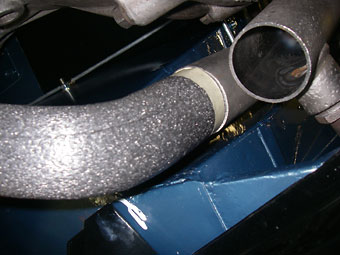
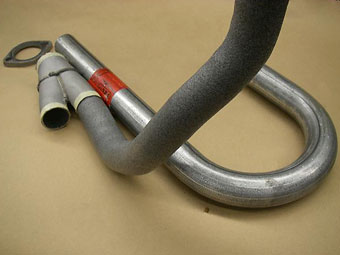
Custom flex-tube tool for exhaust system layout. The tape wraps indicate cut-lines for planned welded joints.
Again, the solution started with a special shop-built layout tool. I went down to the local
hardware store and bought three feet of water pipe insulation wrap for one inch pipe.
I then removed the flex pipe from our shop's parts cleaner solvent tank - it's the pipe
that the solvent comes out of. It can be bent to any configuration required and stay put.
(Like a gooseneck lamp... there must be a name for this stuff!) Next, I pushed the flex
tube through the insulation wrap. Presto! The result was a flexible header pipe that's
prefect for mock-ups. The outside diameter worked especially nicely because I could
stick one end into the existing downpipe end and model the rest as required.
The next two photos show the completed custom exhaust downpipe as finally installed.
I had both the manifold and the downpipe ceramic-coated; the finish looks great plus
it's supposed to lower the surface temperature by as much as 300oF. Note
the self-adhesive mastic sound-deadening sheeting applied to the body in strategic places.
I learned that the stuff that performs well also costs the most.
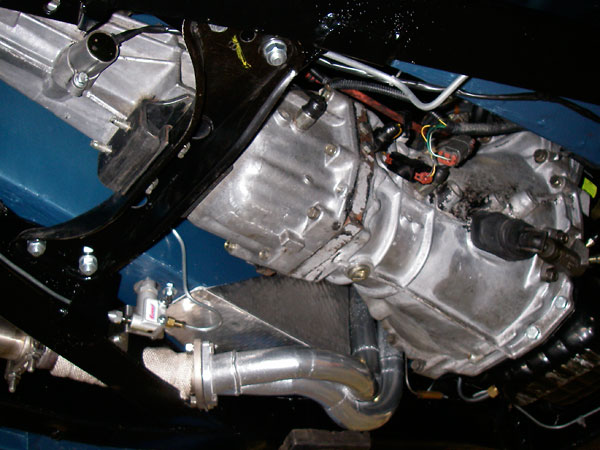
The collector pipe had to go through the frame. I knew this from the early stages of the project, and had cut the elliptical holes way back. To retain the strength of the frame rail, I inserted and welded-in a formed metal pass-thru tube. The collector is welded directly to stainless flex pipe that is wrapped for heat control. The rest of the exhaust is hard-mounted and passes through the frame two more times on its way to the rear muffler.
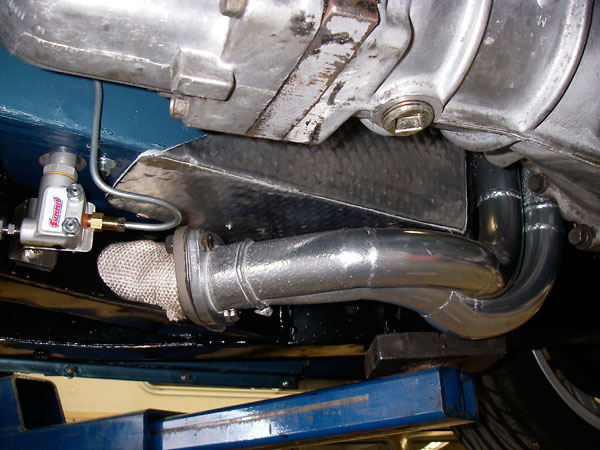
Incidentally, you can also see the rear brake proportioning valve mounted on the frame rail. This valve allows front versus rear brake bias to be adjusted with the turn of a knob. I have this mounted to the frame rail, and the knob emerges just above the carpet on the driver's side floor. That brings us to the driver's compartment... (For more information about the brake system, see below.)
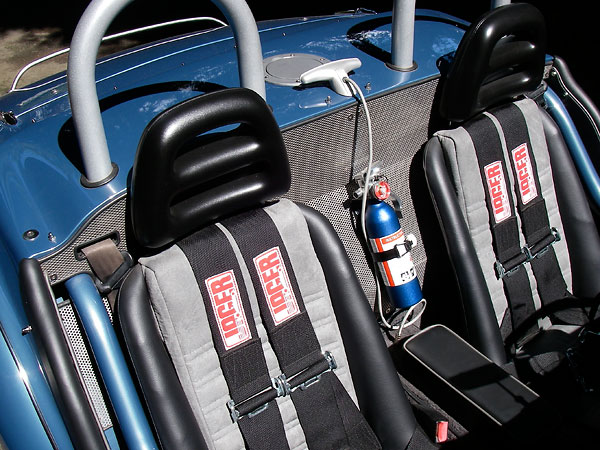
I used Porsche 914 seats because they're well-made, lightweight, and narrow enough
to fit into tight spaces. However, they gave me problems: their integrated headrests
looked too modern for my car plus they didn't allow racecar-style dual shoulder
belts to pass through. I removed the upholstery and cut the fiberglass headrests
off the Porsche seat frames. At a local junkyard, I found removable headrests
from a Nissan Quest that looked like they might integrate with the styling and
functionality I was after. I built a mounting tube assembly and riveted it to
the fiberglass frames, prior to having the seats reupholstered. Grommets at the
top of the re-worked seats facilitate headrest removal, and racing shoulder belts
pass through neatly. Now, the headrests can be adjusted, and they can even be
removed for installation of a tonneau cover. I didn't have to add ugly bulges
to the tonneau cover!
I saved a lot of money making my own patterns for the carpeting. I asked the
owner of the upholstery company if I could do this and he replied: "as long as
they fit!" Well no one else cares as much that they do as me, so off I went. I
used brown paper from a 36" roll and made my patterns to fit edge to edge and
butts at all corners. The carpet guy said he would decide what overlapped what
and by how much. When I was finished he came and checked out my work. After
checking every piece for fit he told me I was hired. We used snaps to hold all
the horizontal pieces down, so they can easily be removed after an unexpected
rainstorm or for service.
Enjoying this article? Our magazine is funded through the generous support of readers like you!
To contribute to our operating budget, please click here and follow the instructions.
(Suggested contribution is twenty bucks per year. Feel free to give more!)
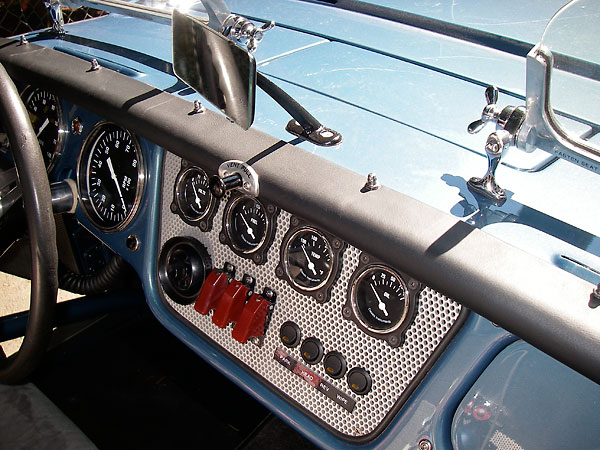
One product I've used extensively throughout this project is 1/8" perforated aluminum sheet. This sheet is available with various combinations of hole-size and spacing, but the options are all 1/8" thick. I used the perforated sheet between the trunk and seating area, for the speaker grille panels and the subwoofer grille, for the dash center and heater grille, for the accelerator pedal scuff panel, and the glove box. It's a soft alloy that cuts easily on a table saw with a carbide blade, or on a band saw with a skip-tooth blade, and it sands easily too. The holes provide easy opportunities for mounting the panels. Did I mention I love this product? The only challenge is how to trim cut edges for a finished appearance. My solution was to take engine vacuum tubing and carefully cut along the length to create inexpensive, custom, flexible rubber trim. I simply glue the trim to the edge of the panel using weatherstrip adhesive. This works very well, but can be a bit messy until you get the hang of it.
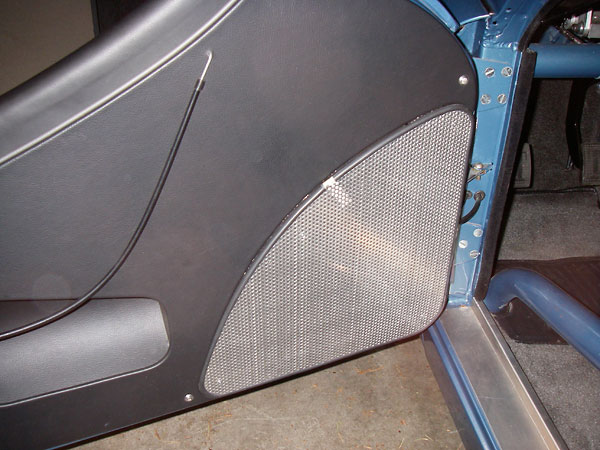
I really enjoyed designing and making a subwoofer box for the audio system. I selected two 8" drivers, and I decided to build a ported enclosure for efficiency. From the published specifications of the drivers, I calculated the optimal volume for the enclosure. (By optimizing enclosure volume and port size, low frequency sound from the port is phased to reinforce the bass output of the drivers. Ported subwoofers can thus be made louder than similarly sized closed box subwoofers. However, to do the job right you need to know the natural frequency of whatever drivers you use.)
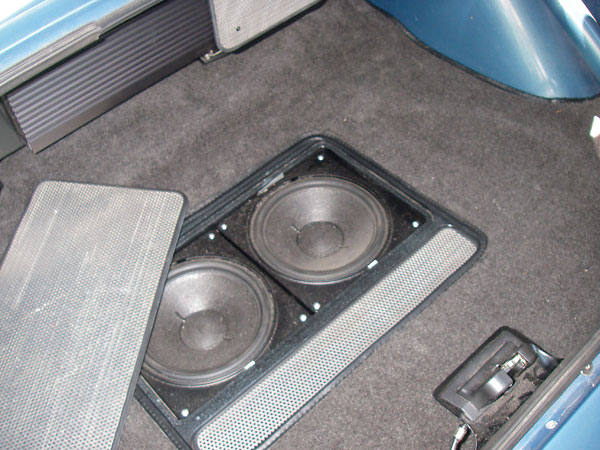
My first plan was to build a removable speaker enclosure and attach it behind the fuel tank. I had the room, as mentioned in the previous article, having re-located the tank closer to the seats by in-filling the bodywork and turning the tank 180 degrees. This mod gave me another 12 inches of trunk space. The issue was that I really hated to give it up for a subwoofer box! The solution was to use part of the spare tire compartment to create the sub volume. In the TR3, the spare tire lives in its own space, just under the trunk floor, but completely separate from it. I determined the size of the sub's front panel based on calculating the volume of the spare tire cavity and matching it to the required volume for the subs. This panel was cut out and replaced with a 3/4" aircraft plywood panel mounted under the trunk floor panel. This was sealed and screwed-down from the top. The drivers were flush mounted in the panel and covered with a grille. The required dimensions of the sub still allowed for about 8 inches of space for storage of items such as the jack, oil, and - you guessed it - a can of "Fix-a-Flat". The division between the two spaces was another carefully fitted and sealed piece of aircraft plywood. Anyone using any form of wood in builds should be sure to seal all surfaces with durable coatings, not just visible surfaces.
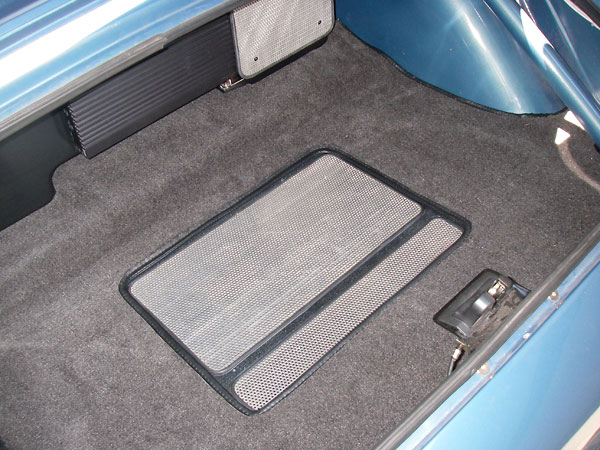
I wanted a remote/hidden trunk release that could be actuated from inside the
car. The wrecking yard once again provided a neat solution. Many early to mid-90's
Honda models use a cable-operated trunk lid release mechanism. A keyed lock is
part of the release mechanism inside the car. It's very cool, and totally adaptable
to custom applications.
I mounted the Nissan PCM on the passenger foot-well. The wiring harness runs from
the main breaker panel to the rear of the car through this area too, so I considered
making a protective aluminum cover for these components. However, I was concerned
aluminum wouldn't match the rest of the car's interior.
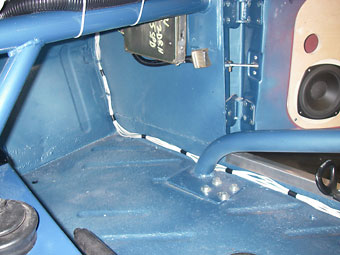
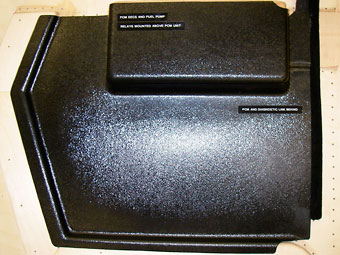
The vacuum-formed panel is 1/8" thick black ABS plastic with a gloss "hair cell" finish on one side.
My solution was to make a formed panel from rugged one eighth inch thick ABS plastic. I borrowed a vacuum-forming machine for the job, and made a mold in the shape I wanted out of wooden blocks attached to plywood. Using putty, these blocks were filleted where they met the board. I drilled a series of eighth inch holes through the base-board about one half inch apart near these filleted corners. The board was sealed onto a vacuum box mounted underneath. The heated ABS sheet was then placed over the form, held by a perimeter framework. The vacuum machine allows the entire form and vacuum box to be raised up and into the softened plastic at the same time that vacuum is applied. Excess material was then trimmed off and the panel fitted in place. I'm happy with the result, and would encourage others to experiment with these techniques.
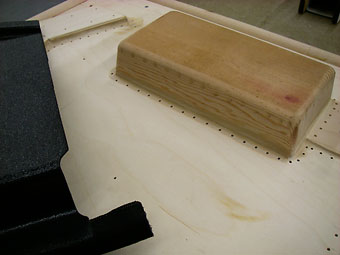
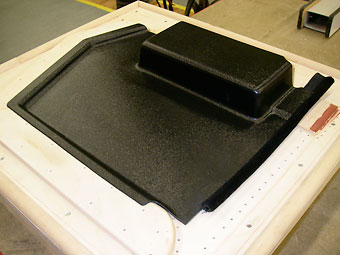
I constructed the male wooden form shown here. You can see the drilled holes that the vacuum pulls through.
About 7 degrees of draft angle is built-in so that molded parts can be pulled out of the mold.
(Note: the part has been removed, trimmed, and placed back in the mold for the photos shown at right.)
Vacuum forming machines are relatively simple and can be built at home. I imagine using a modified electric stove for the heat source and building a roll out rack to clamp the heated ABS sheet. A vacuum pump with about 20 inches of vacuum is needed, as is a way to raise the mold up into the softened plastic as the vacuum is applied. Vacuum forming materials are purchased in flat sheets. They're available in a wide range of thicknesses, colors, materials, and finishes. I'm sure vacuum forming would be a great process for many interior molding details.
I had a lot of issues getting ride height and fender well clearance just right.
I ended up with custom springs that have worked out well. I'm using stock 15"
Nissan 240SX alloy wheels with Yokohama "S Drive" 195-55R performance radials.
I wanted a taller tire, but I couldn't find one that offered comparable performance,
so from my aesthetic point of view the car is too low by about an inch. The
easiest fix would be a taller tire, as I have enough clearance in the fender
openings. I could potentially use a larger wheel, but I really don't like the
current trend of driving on rubber bands!
On the road the car handles much like a set-up Triumph TR6, which it is. The
stiffer springs and shocks, as well as the large front sway bar really flatten
out body roll. The adjustable rear camber set-up by Richard Goodparts works
really well and setting it up was absolutely easy. This system also allows
for slight changes to ride height by equal adjustments at both points. The
shorter front springs did not allow me to get exactly the front geometry I
wanted. I was after 3/4o negative camber and even with all the
lower control arm shims out, my front camber was still a little too negative at
1.2o. I wanted 3o caster, but had to settle for
2.2o. The TR6 front suspension doesn't allow for big changes, and
the only way to get more out of it would have been to design and make an
adjustable upper control arm mounting system. Perhaps down the road... The
solid steering rack blocks I made up did exactly what they were supposed to
do: they translate road feel back to the steering wheel. The Bilstein custom
rear shocks by work great too (and the shop that provided them was quick and
easy to work with.)
The brake system works very well too! Frankly, the TR3 Plus Four has a whole lot
of braking capacity for such a light vehicle: as shown in some detail in the
previous article,
Toyota Four-Runner front brakes squeeze Toyota Cressida vented rotors, and
Nissan 240SX disc brakes are installed at the rear. What about the rest of the
brake system?
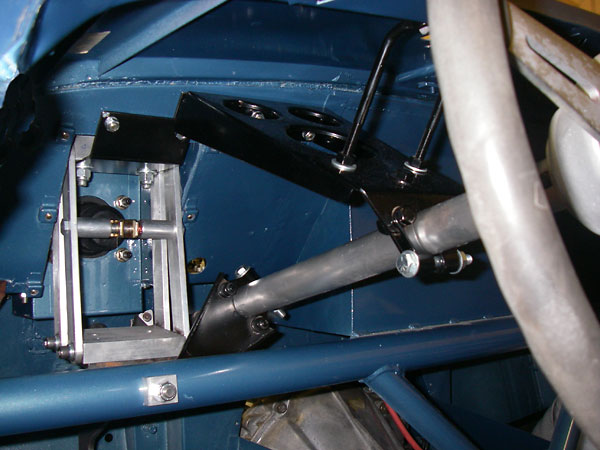
This unusual brake pedal mechanism kept pedal effort (i.e. mechanical advantage ratio),
pedal stroke, and master cylinder piston travel all similar to stock.
A Mazda Miata master cylinder and a Suzuki Swift booster are actuated with a
custom pedal linkage.
As shown earlier in this article, a Summit Racing proportioning valve is
accessible from the driver seat. It acts on the rear brake circuit, and facilitates
tuning of front-to-rear brake bias on the fly (for example, to accomodate a change
in fuel load or adapt for wet road surfaces.)
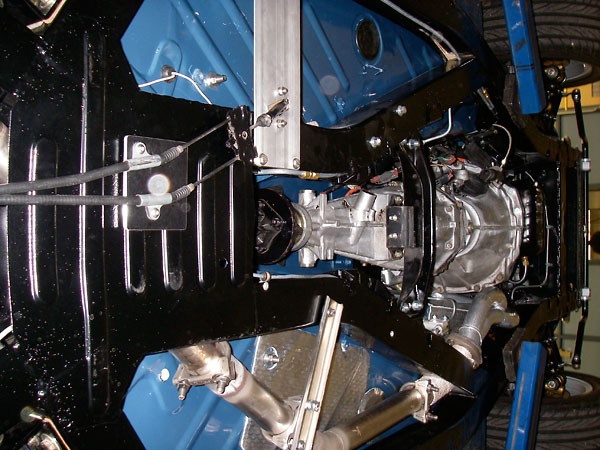
parking brake cables
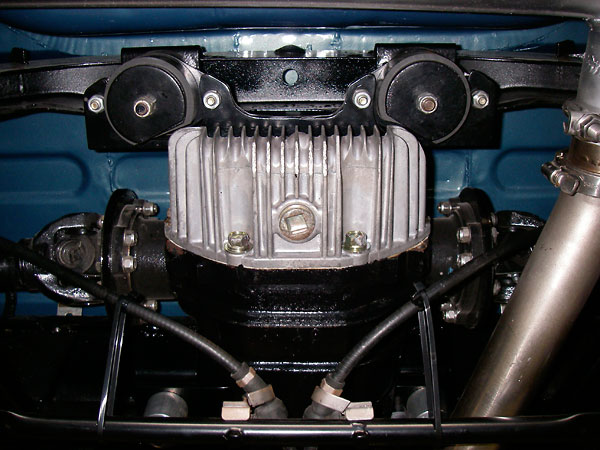
Nissan differential on custom fabricated mounts, with adapter plates that mate to regular TR6 halfshafts.
Acceleration is brisk. The Nissan KA24 engine has a lot of bottom end torque,
and it's not afraid to rev up to the mid 6000's. The engine's power is delivered very
smoothly in comparison to the original Triumph tractor engine, and the 5-speed Nissan
transmission is wonderfully smooth too.
The car gets a lot of attention on the road. I need to rehearse some fast
answers to what are becoming popular questions. What do you say when people
ask "What kind of a car is that?" or says "I used to have one just like that!"
How about: "It's so nice to see one of these restored back to original."
Should I make or break their day?
My conclusion is that we are building hybrids. With this term now applied
through popular culture with respect to multi power sources within the
same vehicle, the real definition of the word has been clouded. And
besides hybrid sounds so much better than bastard!
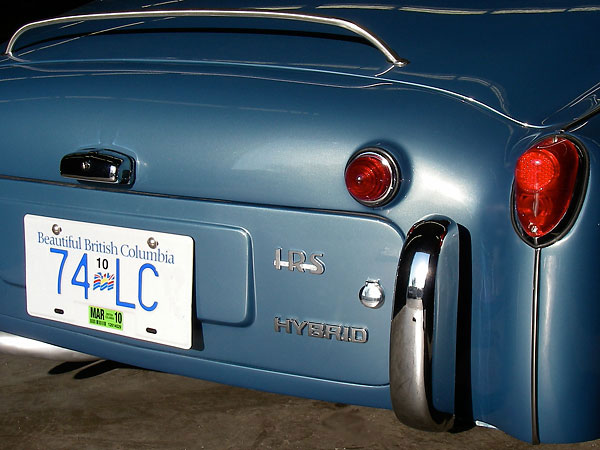
Hybrid \ˈhī-brəd\ n. 1: a crossbred animal or plant; an offspring of two different breeds, genera or varieties.
This article is part two of a two-part series! If you enjoyed this article, you'll enjoy its predecessor:
Randy Schultz's Triumph "TR3 Plus 4" Project, Part 1
A summary of the car's features and specifications appears here:
How It Was Done: Randy Schultz's Triumph TR3
Photos by Randall Schultz for the BritishV8 Magazine. All rights reserved.


